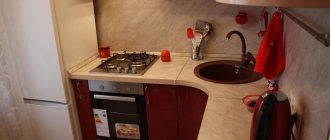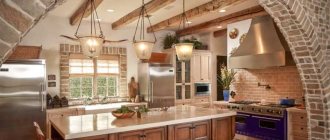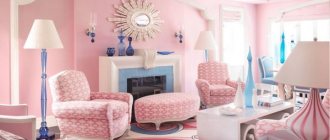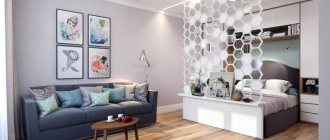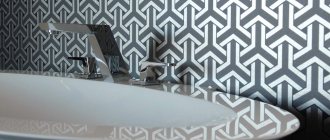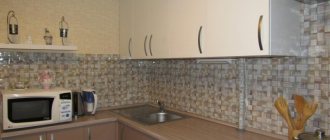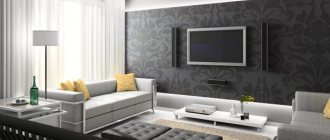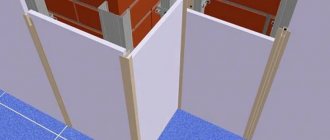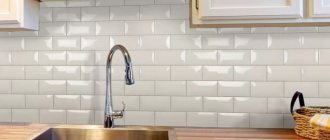Sometimes the influence of time can have a beneficial, rather than destructive, effect on objects. Things turn into antiques and become even more valuable and expensive. Patina, a fashionable and stylish decorative coating that occupies an honorable place in the world of design, can cope with such a task.
Thanks to patina, you can get an extraordinary antique effect, creating a charming atmosphere in any room, including the kitchen. Furniture pieces can become covered with natural patina only after many years of life; such a coating most often appears on copper products.
However, modern decorators have learned to create this amazing coating artificially, using special varnishes, paints and acids. With the help of such means, not only metal objects are aged, but also wooden furniture, as well as other materials.
The patina itself is a greenish tinge that appears on copper over time, under the influence of moisture and air. Patina gradually builds up in layers, making objects more mysterious and similar to museum exhibits.
The use of patina in kitchen interior design
Every housewife wants to have a special kitchen, with an interior that will amaze guests at first glance. Patination is one of the simplest and most accessible ways to achieve this effect. This technique, which makes it possible to artificially “age” objects, is most often used when decorating furniture.
It will be an excellent solution if you want to create a sophisticated and respectable interior with notes of true luxury. There are many patonation technologies, and each of them achieves different effects. For example, the design of a classic kitchen after such treatment will look elegant and solemn.
You can make a patina on furniture with your own hands using special varnishes, primers, finishing paints, abrasive materials for polishing, brushes, and a spray bottle.
When arranging a kitchen in a country or Provence style, it is necessary to achieve the completely opposite effect - the furniture should not look new, slightly shabby, with a touch of history. Such a room will immediately become more comfortable and warm, and it will be pleasant for both household members and guests to stay in it.
Materials and means for patination
You can create a patina that imitates antiquity on objects made from almost any material. These are wood, bronze, iron, copper, gypsum, brass, polyurethane. Having mastered the technology of the patination process, in a few hours you will be able to create a masterpiece with your own hands that is visually no different from works of art of antiquity. The aging effect can be achieved using a special set of materials and means, as well as various technological processes.
- Compositions of the “Patina” series. Patina paint comes in various shades, with the help of which the metal oxidizes in a matter of minutes. A coating forms on the product, the color of which can be green, red or blue. Such compositions are most applicable to wood, metal and gypsum.
- The easiest way to patina yourself is to use acrylic paints, which should be harmoniously combined. The first layer of paint is applied to the product. The next step is to apply a different color (mostly gold or silver) to individual parts with a brush. This method requires imagination and creative desire.
- There are special patination kits, with the help of which the product is transformed into an antique object. By treating wooden, metal, and ceramic surfaces, you will develop a greenish, copper, or golden patina or a worn effect. The main condition is to strictly follow the step-by-step instructions that come with the kit.
Patina on the mirror
Artificial patina applied to a wooden chest of drawers
Patina on metal decor above the fireplace
Patina on wooden furniture close-up
Advice! If the existing paint on the item being decorated is in perfect condition, you can apply patination products on top.
How the process of patoning facades in the kitchen is carried out
The advantages of a process such as patonation are that it can be applied to almost any surface, even to such a simple material as MDF. Before you start work, you need to prepare all the tools and materials. These include: spray bottle, brushes, colorless polyurethane primer, varnish.
To begin with, an insulator is applied to the surface to be treated, that is, to the façade. The soil should be applied evenly, in a very thin layer - a spray bottle can achieve this effect. After this, colorless polyurethane primer is applied to the surface of the facade in the same thin layer. After drying, it must be thoroughly sanded, then the patina itself must be applied. After this, the facades are wiped with a hard or soft sponge (depending on what effect should be achieved).
The more intensive such grinding is, the more aged and textured the facade will look. As soon as this stage of work is completed, glossy or matte varnish should be applied to the surface to be treated in several layers.
Tip: To protect kitchen furniture from moisture and steam, you should use polyurethane varnish.
Advantages and disadvantages of patina in the kitchen
Patoning kitchen facades has a lot of advantages, the main ones include the following:
- High wear resistance - a special composition that is applied to the entire surface, as well as several layers of varnish, help provide reliable additional protection to the facades. They become much less susceptible to steam and moisture.
- Durability - since patina is highly durable, it does not lose its external characteristics even after many years. Thus, the furniture facades are preserved in their original form for a long time.
- Practicality - despite the fact that the patinated surface has a very antique look, it does not require special care using special products. In addition, with the help of abrasions and other signs of antiquity characteristic of patina, you can reliably disguise small cracks, irregularities and dirt.
- Uniqueness - a kitchen design made in this way has an original look. To make the interior as interesting as possible, you should use silver, gold, white, green, black or yellow patina.
- Affordable price - few people can afford real antique furniture. Inexpensive patina will help artificially age any furniture and turn it into a real work of art.
As for the disadvantages of patination, there is only one - this coating tends to ignite easily, so the furniture will have to be kept at a sufficient distance from fire sources. It is also necessary to carefully insulate all wiring in the kitchen.
The emergence of patination in the modern world
Patina is a natural phenomenon to which metal and wood are exposed in natural conditions. It was originally seen on gold, silver and copper coins. Under the influence of the environment and time, a coating began to form on the surface, which gave objects a different appearance. The colors became brighter, cracks and darkening appeared. In this way, the process of surface oxidation, called patination, manifested itself. Items covered with such a coating were of high value. When looking at antique items, you can see the natural patina with the naked eye.
Furniture made from expensive solid wood ages nobly, so art connoisseurs strive to get it for their use. But the price of antiques is too high and not affordable for everyone. Taking into account the needs of people, modern technologists have developed a technique for artificial aging of wood and MDF. This innovation received the term “patination”.
What are the types of patina?
Patina varies in shades and in the decorative effect it can create. The choice of material should depend on what style of interior will be created in the kitchen, and what initial shade the set has. There are many types of patina. It is worth considering the most popular of them.
Silver or golden patina is a universal option, but it is recommended to use it in a white or black kitchen, as well as on light wood furniture. On dark facades, white trim will look more impressive, and on light facades, gray, black, yellow and brown. For a patina of golden and silver tones, it is worth choosing a matte, rather than glossy, varnish.
For a patina of golden and silver tones, you should choose a matte varnish.
Contrasting patina - it will help to highlight and highlight carved patterns on furniture facades. It is worth choosing shades of silver, gold, bronze, copper. First, such compounds are rubbed into the joints of the panel and frame, in the corners, or onto other milling elements. Then the main thin layer is applied on top.
A light brown kitchen has a golden patina.
Patina with a craquelure or crackle effect is ideal for finishing kitchen furniture in country, shabby chic, and Provence styles. The facades are coated with a special craquelure varnish, which, after drying, is immediately covered with a network of cracks reminiscent of old paint. After this, a contrasting patina is very carefully rubbed into the cracks, and the final stage is the application of a layer of varnish.
Kitchen with craquelure or crackle effect.
What interior style should you choose for a kitchen with patina?
Patina is applied in order to artificially age the furniture, give it a more antique look, and create the illusion that it is many years old. This means that patina should not be used in any modern interior design.
Ideal design solutions that go well with a touch of antiquity on furniture - kitchen interiors in country style, Provence, shabby chic. Patina would look quite appropriate in a classic interior, but in this case it is necessary to use more expensive shades of coating - gold, bronze, copper.
Facades with patina look chic and create a classic style.
Thanks to patina, you can create a unique atmosphere in the room, giving the interior originality and uniqueness.
Compatibility of patina with different styles of kitchens
Patina is a greenish coating that, over time, seems to grow on the surface of the furniture in layers.
A multi-layer effect is created. This phenomenon can be compared to ivy gradually covering buildings - elegant and beautiful.
So what interior styles will this coating go well with? Definitely, these are two strikingly opposing design styles: classic and Provence. Let's take a closer look at the design of kitchens with patina in these designer images.
What color to choose for decorating the interior of a kitchen with patina
A white kitchen with patina is an excellent solution for creating an elegant and cozy kitchen. The white color harmonizes perfectly with the patina; this set looks very gentle and resembles real antique furniture.
Ideal shades for decorating white facades are blue, green, purple. Be sure to use details in cream, beige and brown tones with gold. Panels will help make facades more elegant.
Light shades of green on a white background look very beautiful.
Green kitchen with patina - most often this option is chosen when decorating the interior in a light and airy shabby chic style. This combination is also suitable for creating a country-style kitchen. To make the kitchen look truly unusual and attractive, it is recommended to use the lightest shades of green. They will harmonize perfectly with white, blue, gray, brown and beige patina.
Kitchen set in Provence style.
A black kitchen with patina is a very original solution, which cannot be applied in every interior. It is desirable that the kitchen with such furniture be quite spacious and bright. A matte black kitchen set will look great with a gold, silver or white patina. Silver or gold fittings would be a worthy decoration.
Black kitchen with silver patina.
Gray kitchen with patina - you shouldn’t treat this noble shade as something plain and boring. Gray can look luxurious and expensive, especially when combined with the patina of black, blue, white and green. Such a set will look very harmonious, sophisticated and elegant. Gray tones never tire, and they combine perfectly with any other colors. In addition, this interior design solution is suitable for both spacious and small kitchens.
Small scratches and dirt are less visible on textured surfaces.
A brown kitchen with patina is perhaps the best solution for creating a rustic interior or a country-style interior in the kitchen. The patina in this case can have yellow, gray, blue, green, beige and purple tones. Brown color is also perfect for a classic interior, but the patina should be chosen in golden or bronze tones.
Over the years, the patination effect does not disappear.
A beige kitchen with patina is an ideal solution for a classic interior, as well as arranging a kitchen in Provence and shabby chic styles. Patina of any tones harmonizes perfectly with beige shades, but to make the kitchen look more delicate and elegant, you should opt for light colors. An excellent solution would be a patina of gray, pale blue, light green, soft lilac and light golden shades.
Solid wood with patina looks incredibly impressive.
A red kitchen with patina is a very bold option for a kitchen interior, but quite appropriate when it comes to country style. The main thing is that the red color is sufficiently muted; preference should be given to its burgundy tones. As for patina, it can be black, brown, gray, white, beige, terracotta.
The patination effect not only looks impressive but also rich.
Classic style
Thanks to different spraying techniques, you can give a modern kitchen with a patina both an aristocratic look and a share of rustic notes. As mentioned above, one of the leading styles that goes well with patina is the classic style.
The decisive role in the creation of one or another stylistic motif is the base color of the facade. It is this that creates the basis for the entire image of a classic kitchen with patina.
Therefore, if you are a supporter of classics and consistency, choose light colors. Against the background of delicate shades of the base, patina looks most advantageous and transfers all the emphasis to itself.
In order for a classic kitchen set with patina to fully convey all the charm and emphasize the subtlety of the owners’ taste, it is necessary to take care of the correct decoration of the room.
The best and win-win solution would be the absence of additional sharp accents in decorating the kitchen space.
This is because a classic kitchen with patina is a self-sufficient decor that does not require additional elements to create a complete image.
How to choose the right kitchen with patina - useful tips
- As a rule, patinated kitchens are made to order. If you need to save money, you can choose headsets made from materials such as MDF or chipboard. It’s worth taking a closer look at the lightly embossed textures that are most reminiscent of natural wood.
- The most inexpensive are the sets whose facades are solid and straight. Grilles, glass inserts, radius doors and appropriate fittings will help make the interior more “expensive”.
- An average price option is a kitchen made of veneered MDF. This material is practically no different in appearance from solid wood.
- The most expensive option for a patinated kitchen is furniture made from solid ash, oak, beech and other hard woods. The surface of such facades is tinted with matte enamel in pastel or neutral shades.
- To give patina-covered doors a more textured appearance, they can be brushed using a special brush, which leaves characteristic irregularities on the facade. They are perfectly filled with a patina coating.
